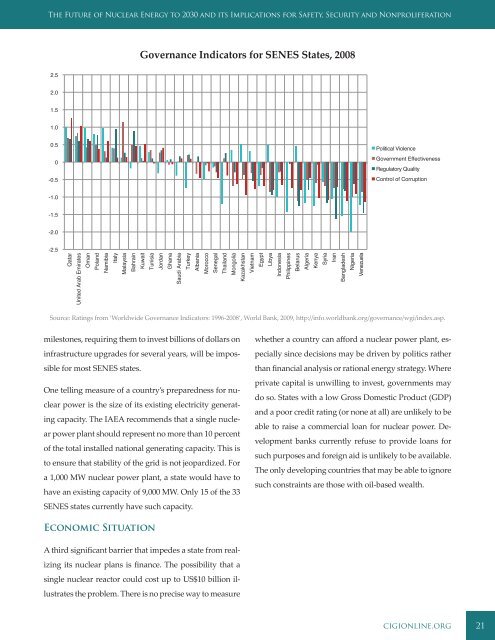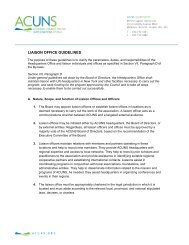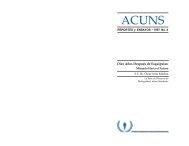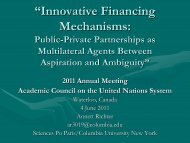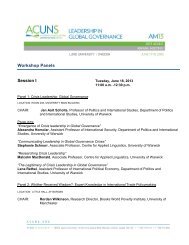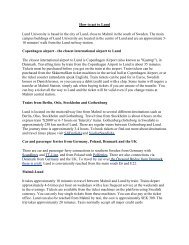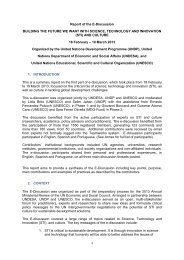THE FUTURE OF NUCLEAR ENERGY TO 2030 AND ITS ... - acuns
THE FUTURE OF NUCLEAR ENERGY TO 2030 AND ITS ... - acuns
THE FUTURE OF NUCLEAR ENERGY TO 2030 AND ITS ... - acuns
Create successful ePaper yourself
Turn your PDF publications into a flip-book with our unique Google optimized e-Paper software.
The Future of Nuclear Energy to <strong>2030</strong> and its Implications for Safety, Security and Nonproliferation<br />
Governance Indicators for SENES States, 2008<br />
2.5<br />
2.0<br />
1.5<br />
1.0<br />
0.5<br />
0<br />
-0.5<br />
Political Violence<br />
Government Effectiveness<br />
Regulatory Quality<br />
Control of Corruption<br />
-1.0<br />
-1.5<br />
-2.0<br />
-2.5<br />
Qatar<br />
United Arab Emirates<br />
Oman<br />
Poland<br />
Namibia<br />
Italy<br />
Malaysia<br />
Bahrain<br />
Kuwait<br />
Tunisia<br />
Jordan<br />
Ghana<br />
Saudi Arabia<br />
Turkey<br />
Albania<br />
Morocco<br />
Senegal<br />
Thailand<br />
Mongolia<br />
Kazakhstan<br />
Vietnam<br />
Egypt<br />
Libya<br />
Indonesia<br />
Philippines<br />
Belarus<br />
Algeria<br />
Kenya<br />
Syria<br />
Iran<br />
Bangladesh<br />
Nigeria<br />
Venezuela<br />
Source: Ratings from ‘Worldwide Governance Indicators: 1996-2008’, World Bank, 2009, http://info.worldbank.org/governance/wgi/index.asp.<br />
milestones, requiring them to invest billions of dollars on<br />
infrastructure upgrades for several years, will be impossible<br />
for most SENES states.<br />
One telling measure of a country’s preparedness for nuclear<br />
power is the size of its existing electricity generating<br />
capacity. The IAEA recommends that a single nuclear<br />
power plant should represent no more than 10 percent<br />
of the total installed national generating capacity. This is<br />
to ensure that stability of the grid is not jeopardized. For<br />
a 1,000 MW nuclear power plant, a state would have to<br />
have an existing capacity of 9,000 MW. Only 15 of the 33<br />
SENES states currently have such capacity.<br />
whether a country can afford a nuclear power plant, especially<br />
since decisions may be driven by politics rather<br />
than financial analysis or rational energy strategy. Where<br />
private capital is unwilling to invest, governments may<br />
do so. States with a low Gross Domestic Product (GDP)<br />
and a poor credit rating (or none at all) are unlikely to be<br />
able to raise a commercial loan for nuclear power. Development<br />
banks currently refuse to provide loans for<br />
such purposes and foreign aid is unlikely to be available.<br />
The only developing countries that may be able to ignore<br />
such constraints are those with oil-based wealth.<br />
Economic Situation<br />
A third significant barrier that impedes a state from realizing<br />
its nuclear plans is finance. The possibility that a<br />
single nuclear reactor could cost up to US$10 billion illustrates<br />
the problem. There is no precise way to measure<br />
cigionline.org 21


